Related Research Articles

The Schutzstaffel was a major paramilitary organisation under Adolf Hitler and the Nazi Party in Nazi Germany, and later throughout German-occupied Europe during World War II.

Einsatzgruppen were Schutzstaffel (SS) paramilitary death squads of Nazi Germany that were responsible for mass murder, primarily by shooting, during World War II (1939–1945) in German-occupied Europe. The Einsatzgruppen had an integral role in the implementation of the so-called "Final Solution to the Jewish question" in territories conquered by Nazi Germany, and were involved in the murder of much of the intelligentsia and cultural elite of Poland, including members of the Catholic priesthood. Almost all of the people they murdered were civilians, beginning with the intelligentsia and swiftly progressing to Soviet political commissars, Jews, and Romani people, as well as actual or alleged partisans throughout Eastern Europe.
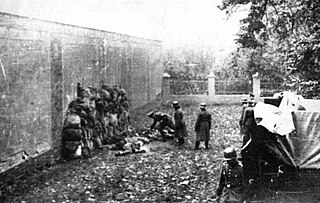
During World War II, the Nazi German Einsatzkommandos were a sub-group of the Einsatzgruppen – up to 3,000 men total – usually composed of 500–1,000 functionaries of the SS and Gestapo, whose mission was to exterminate Jews, Polish intellectuals, Romani, and communists in the captured territories often far behind the advancing German front. Einsatzkommandos, along with Sonderkommandos, were responsible for the systematic murder of Jews during the aftermath of Operation Barbarossa, the invasion of the Soviet Union. After the war, several commanders were tried in the Einsatzgruppen trial, convicted, and executed.
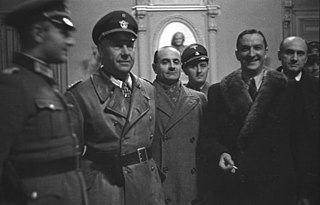
The Sicherheitspolizei, often abbreviated as SiPo, was a term used in Germany for security police. In the Nazi era, it referred to the state political and criminal investigation security agencies. It was made up by the combined forces of the Gestapo and the Kriminalpolizei between 1936 and 1939. As a formal agency, the SiPo was incorporated into the Reich Security Main Office (RSHA) in 1939, but the term continued to be used informally until the end of World War II in Europe.

Franz Walter Stahlecker was commander of the SS security forces (Sicherheitspolizei and the Sicherheitsdienst for the Reichskommissariat Ostland in 1941–42. Stahlecker commanded Einsatzgruppe A, the most murderous of the four Einsatzgruppen active in German-occupied Eastern Europe. He was fatally wounded in action by Soviet partisans and was replaced by Heinz Jost.
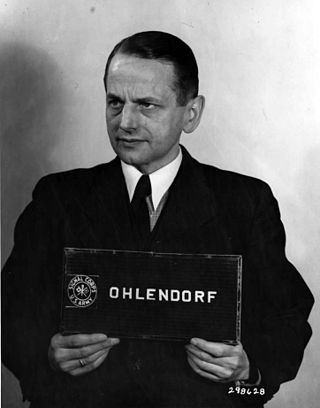
Otto Ohlendorf was a German SS functionary and Holocaust perpetrator during the Nazi era. An economist by education, he was head of the Sicherheitsdienst (SD) Inland, responsible for intelligence and security within Germany. In 1941, Ohlendorf was appointed the commander of Einsatzgruppe D, which perpetrated mass murder in Moldova, south Ukraine, the Crimea and, during 1942, the North Caucasus. He was tried at the Einsatzgruppen Trial, sentenced to death, and executed by hanging in 1951.
Martin Broszat was a German historian specializing in modern German social history. As director of the Institut für Zeitgeschichte in Munich from 1972 until his death, he became known as one of the world's most eminent scholars of Nazi Germany.

Karl Jäger was a German mid-ranking official in the SS of Nazi Germany and Einsatzkommando leader who perpetrated acts of genocide during the Holocaust.

Martin Sandberger was a German SS functionary during the Nazi era and a convicted Holocaust perpetrator. He commanded Sonderkommando 1a of Einsatzgruppe A, as well as the Sicherheitspolizei and SD at the time of Nazi German occupation of Estonia during World War II. Sandberger perpetrated mass murder of the Jews in German-occupied Latvia and Estonia. He was also responsible for the arrest of Jews in Italy, and their deportation to Auschwitz concentration camp. Sandberger was the second-highest official of the Einsatzgruppe A to be tried and convicted. He was also the last-surviving defendant from the Nuremberg Military Tribunals.
Hans Ehlich was a doctor and SS-Standartenführer (colonel) of Nazi Germany during World War II. He was the commander of Amtsgruppe III B Volkstum und Volksgesundheit in the Sicherheitsdienst (SD) in occupied Poland.
Rudolf Batz was a German SS functionary during the Nazi era. From 1 July to 4 November 1941 he was the leader of Einsatzkommando 2 and as such was responsible for the mass murder of Jews and others in the Baltic states. Arrested in 1961, Batz committed suicide while in custody awaiting trial.
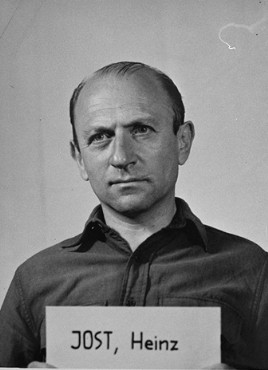
Heinz Jost was a German SS functionary during the Nazi era. He was involved in espionage matters as the Sicherheitsdienst or (SD) section chief of office VI of the Reich Security Main Office. Jost was responsible for genocide in eastern Europe as commander of Einsatzgruppe A from March–September 1942.

Karl Rudolf Werner Braune was a German SS functionary during the Nazi era and a Holocaust perpetrator. During the German invasion of the Soviet Union of 1941, Braune was the commander of Einsatzkommando 11b, part of Einsatzgruppe D. Braune organized and conducted mass murders of Jews in the Army Group South Rear Area, the Reichskommissariat Ukraine. For his role in these crimes, Braune was tried before an American military court in 1948 in the Einsatzgruppen trial. He was convicted, sentenced to death and executed in 1951.
Walther Karl Johannes Bierkamp, also sometimes spelled Walter Bierkamp was a German Nazi lawyer and SS-Brigadeführer. During the Second World War, he served as Commander of the Sicherheitspolizei or SiPo and Sicherheitsdienst or SD in occupied Belgium and Northern France and later in occupied Poland and in Baden & Württemberg. He also commanded Einsatzgruppe D, in the occupied Soviet Union. He was involved in Holocaust-related war crimes in Poland and the North Caucasus area. After the end of the war in Europe, he committed suicide.
Kriminalpolizei, often abbreviated as Kripo, is the German name for a criminal investigation department. This article deals with the agency during the Nazi era.
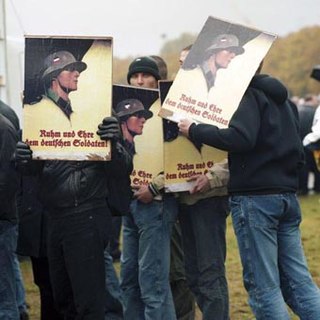
The myth of the clean Wehrmacht is the negationist notion that the regular German armed forces were not involved in the Holocaust or other war crimes during World War II. The myth, heavily promoted by German authors and military personnel after World War II, completely denies the culpability of the German military command in the planning and perpetration of war crimes. Even where the perpetration of war crimes and the waging of an extermination campaign, particularly in the Soviet Union – where the Nazis viewed the population as "sub-humans" ruled by "Jewish Bolshevik" conspirators – has been acknowledged, they are ascribed to the "Party soldiers corps", the Schutzstaffel (SS), but not the regular German military.
Günther Herrmann was a functionary in the SS of Nazi Germany during World War II and a convicted criminal. He commanded the Sonderkommando 4b and the Einsatzkommando 12 of the Einsatzgruppe C in the occupied Soviet Union and the Einsatzgruppe E in Croatia. In 1973, Herrmann was convicted for the murders committed in 1941–42 in the occupied Soviet Union and was sentenced to seven years in prison.
Manfred Messerschmidt was a German historian who specialised in the history of Nazi Germany and World War II. He was the longtime research director at the Military History Research Office (MGFA) who conceived and launched the seminal series of books Germany and the Second World War, edited by the MGFA.
The Police Battalion 45 was a formation of the German Order Police during the Nazi era. During Operation Barbarossa, it was subordinated to the SS and deployed in German-occupied areas, specifically the Army Group Centre Rear Area, of the Soviet Union, as part of Police Regiment South. Alongside detachments from the Einsatzgruppen of the SD and the 1st SS Infantry Brigade of the Waffen-SS, it perpetrated mass murder in the Holocaust and was responsible for large-scale crimes against humanity targeting civilian populations.
References
Citations
- 1 2 3 Munzinger 1990.
- ↑ Fritz Bauer Institut: Auschwitz: Geschichte, Rezeption und Wirkung. Campus, Frankfurt/Main 1996, S. 135, N. 26.
- 1 2 Merkl 1983.
- ↑ Longerich 2010, pp. 188, 436.
- ↑ Morina 2011, p. 220.
- 1 2 3 Der Spiegel 1981.
- ↑ Loeffel 2009, p. 514.
- ↑ Frei 1997, p. 65.
- ↑ Norbert Frei, Abschied von der Zeitgenossenschaft: Der Nationalsozialismus und seine Erforschung auf dem Weg in die Geschichte ("Farewell to the Era of Contemporaries"), 1998 p. 74
Bibliography
- "Goldes wert. Ein deutscher Historiker widerlegt die gängige These, die Wehrmacht habe mit den Mordaktionen der Einsatzgruppen in Rußland nichts zu tun gehabt" [A German historian disproves the common thesis that the Wehrmacht had nothing to do with the killings of the Einsatzgruppen in Russia] (in German). Der Spiegel. April 13, 1981. Retrieved September 21, 2019.
- Frei, Norbert (1997). "Farewell to the Era of Contemporaries". History & Memory . 9 (1/2 Fall/Winter): 59–80. doi:10.2979/HIS.1997.9.1-2.59. ISSN 0935-560X.
- Loeffel, Robert (2009). "Soldiers and Terror: Re-evaluating the Complicity of the Wehrmacht in Nazi Germany". German History . 27 (4): 514–530. doi:10.1093/gerhis/ghp078.
- Longerich, Peter (2010). Holocaust: The Nazi Persecution and Murder of the Jews. Oxford; New York: Oxford University Press. ISBN 978-0-19-280436-5.
- Merkl, Peter H. (1983). "Review: Die Truppe des Weltanschauungskrieges: Die Einsatzgruppen der Sicherheitspolizei und des SD, 1938-1942". The Journal of Modern History . The University of Chicago Press. 55 (3): 582–584. doi:10.1086/242560. JSTOR 1878640.
- Morina, Christina (2011). Legacies of Stalingrad: Remembering the Eastern Front in Germany since 1945. Cambridge University Press. ISBN 978-1107013049.
- "Krausnick, Helmut". Munzinger: Internationales Biographisches Archiv. Munzinger-Archiv. 12 (March). 1990. Retrieved September 21, 2019.